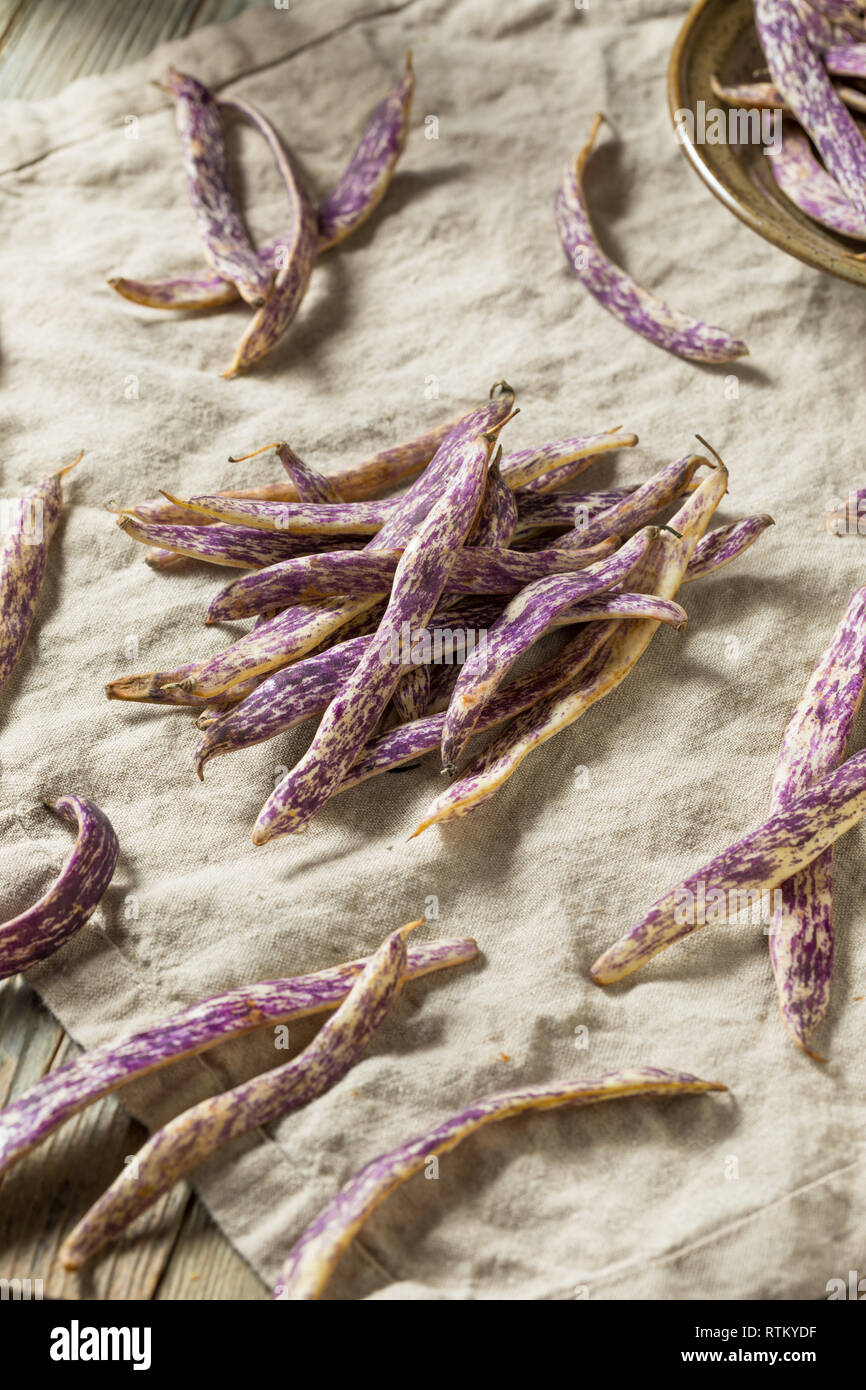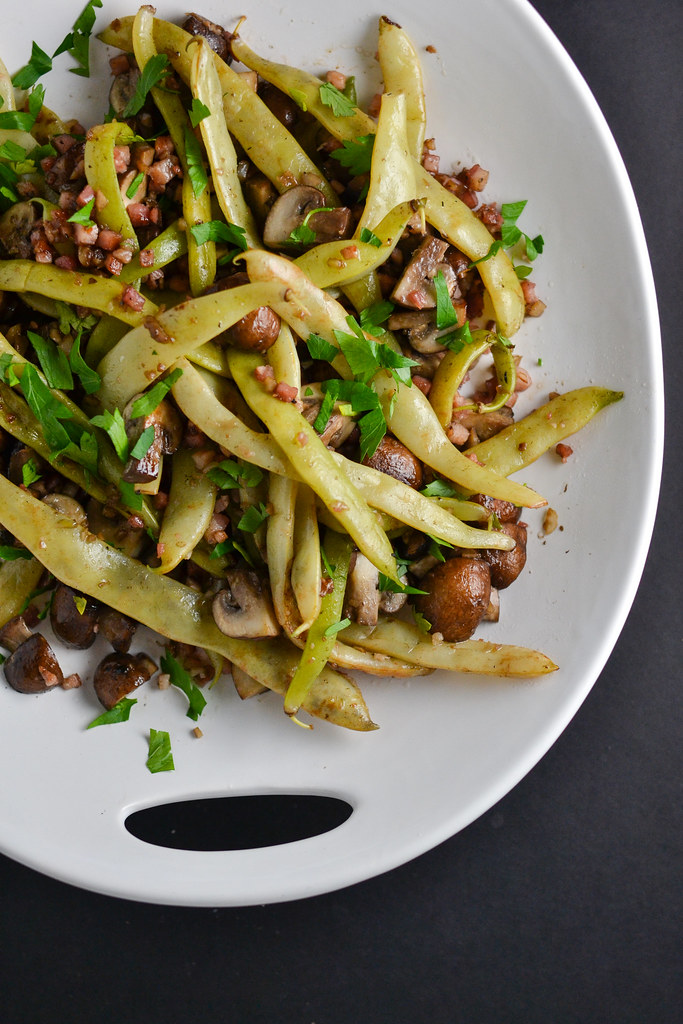When I first encountered dragon tongue beans, I was captivated by their vibrant green and crimson streaks. As I learned more about this unique vegetable, I discovered its culinary versatility and exceptional nutritional value. This article will guide you through the art of cooking dragon tongue beans, exploring their history, culinary applications, and the latest trends in their use.

Image: www.alamy.com
Get ready to tantalize your taste buds and expand your culinary horizons. Let’s dive into the world of dragon tongue beans!
A Botanical Journey into Dragon Tongue Beans
Dragon tongue beans, known scientifically as Phaseolus vulgaris, belong to the legume family. Native to Central and South America, these beans have been a staple food for centuries. Their eye-catching pods, featuring a vibrant green base splashed with crimson streaks, have earned them the moniker dragon tongue beans.
Dragon tongue beans are a rich source of dietary fiber, protein, and vitamins. Their unique phytochemical composition, including flavonoids and anthocyanins, contributes to their antioxidant and anti-inflammatory properties.
Cooking Dragon Tongue Beans: A Culinary Canvas
Preparing dragon tongue beans is a culinary journey brimming with possibilities. They can be enjoyed fresh, blanched, steamed, sautéed, or roasted, presenting a spectrum of textures and flavors.
For fresh dragon tongue beans, simply trim the ends and wash them thoroughly. They can be added to salads, stir-fries, and soups, adding a vibrant crunch and nutritional boost. Blanching, involving brief immersion in boiling water, is ideal for preserving their freshness and color while maintaining their crisp texture. Steaming retains both nutrients and flavor, making it a gentle cooking method that enhances their natural sweetness.
Sautéing and Roasting: Unveiling Aromatic Depths
Sautéing dragon tongue beans in a dash of olive oil and garlic allows their flavors to bloom. Their tender-crisp texture and savory notes make them an excellent addition to pasta dishes and vegetable medleys.
Roasting, at a higher temperature than sautéing, transforms dragon tongue beans into a caramelized delight. Their sugars caramelize, intensifying their sweetness, while their skins become slightly charred, adding a smoky depth. Roasted dragon tongue beans pair perfectly with hearty meats and roasted vegetables.

Image: www.thingsimadetoday.com
Modern Culinary Explorations: Dragon Tongue Bean Innovation
Contemporary cuisine embraces the versatility of dragon tongue beans, incorporating them into innovative dishes. Chefs are experimenting with pickling and fermenting these beans, adding a unique tang and umami flavor to culinary creations.
Pickled dragon tongue beans, with their vibrant colors and tangy vinegar brine, serve as a vibrant garnish or side dish. Fermented dragon tongue beans, packed with probiotics and complex flavors, add a rich depth to salads, soups, and stews.
Tips and Expert Advice for Cooking Dragon Tongue Beans
To elevate your dragon tongue bean culinary experiences, consider these tips from seasoned chefs:
- Choose Fresh Beans: Opt for brightly colored, plump, and firm dragon tongue beans for optimal texture and flavor.
- Trim Sparingly: Trim only the bean’s stem end, preserving the bean’s nutritional content and visual appeal.
- Cook According to Variety: Flat dragon tongue beans require slightly longer cooking than round varieties. Adjust cooking times accordingly for the best texture.
- Enhance Flavor: Experiment with adding herbs, spices, or sauces to enhance the beans’ natural flavors. Garlic, ginger, and a touch of soy sauce are excellent flavor enhancers.
- Serve with Confidence: Dragon tongue beans are a versatile side dish that complements grilled meats, roasted vegetables, or pasta dishes. Their vibrant colors and unique flavor will impress your guests.
Expert Insight: Unlocking Culinary Secrets
Renowned chef Julia Jones shares her expert advice on cooking dragon tongue beans:
“Dragon tongue beans possess an earthy sweetness that pairs well with pungent flavors. Sauté them with garlic and anchovies for a savory twist. Alternatively, try roasting them with a drizzle of honey and a sprinkle of cumin seeds to create a caramelized and aromatic delight.”
Frequently Asked Questions
Q: Are dragon tongue beans safe to eat raw?
A: Yes, dragon tongue beans are safe to consume raw. However, cooking enhances their digestibility and reduces the potential for gas production.
Q: How can I store dragon tongue beans?
A: Store unwashed dragon tongue beans in a perforated plastic bag in the refrigerator for up to 5 days. Avoid washing them before storing, as moisture can promote spoilage.
Q: Can I freeze dragon tongue beans?
A: Yes, you can freeze dragon tongue beans for up to 1 year. Blanch them briefly before freezing to preserve their color and texture.
How To Cook Dragon Tongue Beans
Conclusion
Dragon tongue beans are a culinary gem, offering a vibrant palette of colors, flavors, and nutritional benefits. Embrace their versatility by incorporating them into your culinary repertoire, whether fresh, blanched, steamed, sautéed, or roasted.
Join the culinary adventure of dragon tongue beans! Explore their unique tastes and textures, pushing the boundaries of your cooking prowess.
Have you tantalized your taste buds with dragon tongue beans? Share your cooking experiences and ask any lingering questions in the comments section below!